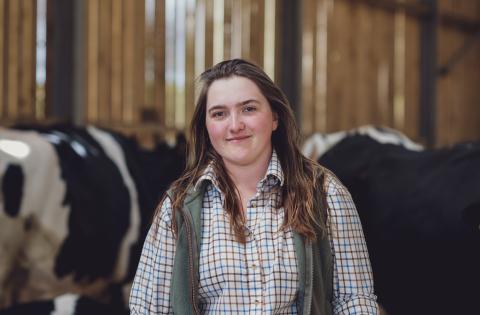Lottie is a first-year agriculture student at Nottingham University. Having grown up at her family’s 650 acre dairy farm near Haverfordwest and through a year working in the industry during her foundation studies at Hartpury College, she has plenty of hands-on experience. Her family have a 300 head Holstein Friesian all year-round calving herd and operate a semi- intensive system, grazed around six months of the year.
“Poor foot health is a major contributor to cattle performance, which can lead to reduced fertility, yield and longevity. By shadowing some of the industry’s leading academics in this field, I aim to learn more about issues including digital dermatitis, antibiotic use, and management techniques to improve lameness rates.”
EXECUTIVE SUMMARY
Dairy farmer says early intervention on cow lameness treatment crucial to profitability
A young farmer is helping to drive improvements in foot health in her family’s dairy herd through a series of protocols informed by her Farming Connect Management Exchange programme research.
Lottie Wilson’s family milk 320 Holstein Friesian cows near Haverfordwest.
The University of Nottingham agriculture student says that while lameness isn’t a major problem in the herd she is keen to reduce incidence, to improve fertility, milk production, and longevity, thereby reducing antibiotic usage and cost of production.
Lottie embarked on a Farming Connect Management Exchange programme study, allowing her to spend time with cattle foot health expert Professor George Oikonomou and his team at the University of Liverpool and specialist cattle foot health vet Sara Pedersen.
She gained knowledge on the issues around lameness – and on the practical solutions to prevent it.
She has now introduced a programme in the herd of routinely foot bathing dry cows and actively looking for digital dermatitis and treating it promptly.
After seeing the huge benefits of foot trimming techniques, Lottie has also embarked on foot trimming and mobility scoring courses.
Recording and measuring herd lameness levels and its causes is important in every herd, she suggests.
“Knowing the herd statistics can allow you to identify and target areas for improvement sooner and results can be seen and measured, hopefully proving time and money is being used in the right ways,’’ she says.
To deliver this ambition, farmers should utilise all resources and personnel available – from farm staff and foot trimmers to vets, consultants and other farmers, Lottie adds.
“All are able to help with solutions to problems with lameness and using the entire team will help ensure the best results for the cows and the business.’’
Milking is the ideal opportunity to check feet.
“Standing within six inches of a cow’s back feet twice daily should allow you to identify many problems early, especially digital dermatitis,’’ says Lottie.
“Use this to your advantage and take the time to look and treat accordingly.’’
She warns against ignoring foot health in dry cows and in-calf heifers - foot bathing and lameness scoring is often neglected in the dry period.
And, above all, acting early is crucial, she adds.
“Lameness can cost the business thousands of pounds very quickly, identify the areas that are causing issues and invest early.’’
MANAGEMENT EXCHANGE REPORT


